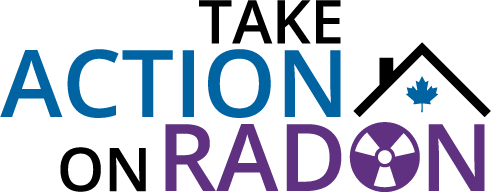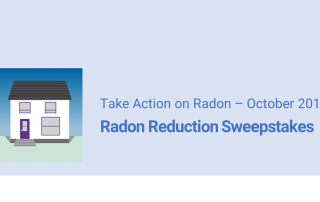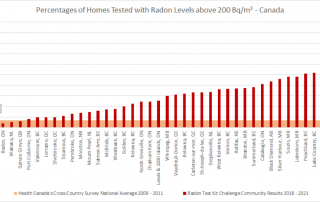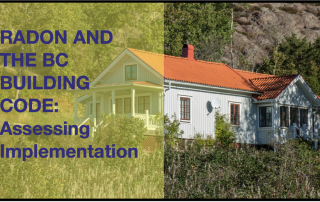Receiving your radon test results?
If you have tested your home with an alpha track detector (one use detector), you should receive your radon test report by email approximately 8 weeks after the lab has received it. If you have not received your report yet, most radon test labs email the reports out and so you may want to check your spam folder, add their email address to your servers approved email list or reach out to them and see where your results are. Have questions? You [...]
Radon Reduction Sweepstakes Report 2019-2020
Evaluating entries from 2019/2020, we continue to see that most people reducing radon are seeing effective results in their radon levels of 91% reduction when using a C-NRPP certified professional and that pricing of radon mitigation systems seems ranges by home and region, however the general average is around $2,700 across the country. Download the full report Download the Infographic Summary C-NRPP professionals reduced radon levels to below 100 Bq/m3 over 94% of the time, and to below [...]
Radon Reduction Sweepstakes Report 2017-2019
The Radon Reduction Sweepstakes is a Canada-wide contest run by Take Action on Radon (TAOR) in conjunction with the Canadian Association of Radon Scientists and Technologists (CARST). The contest provides 10 prizes of up to $1,000 each to homeowners who have tested their home for radon and used a C-NRPP professional to reduce levels to below Canada’s recommended guideline of 200 Bq/m3. A key part of TAOR’s mandate is to encourage Canadians to take action on radon, and the Sweepstakes does just that with the [...]
Take Action on Radon Preliminary Data Report – November 2021
A new report by Take Action on Radon (TAOR) reveals that the overwhelming majority of communities that have taken part in their 100 Radon Test Kit Challenge program are finding that dangerous levels of radon are much more common that Health Canada’s national estimate or 7% of Canadian homes have elevated radon levels – would suggest. The 100 Radon Test Kit Challenge program takes a Citizen Science approach to gathering data on radon levels. A turn-key program, it was designed to engage and support communities [...]
Radon and the BC Building Code: Assessing Implementation
Radon can become trapped and accumulate in your home and other buildings unless systems are installed to prevent it. The BC Building Code now requires “extended radon rough-ins”—basic systems that can be upgraded once homes are occupied to ensure radon levels remain under Canada’s Radon Guideline in certain areas according to Table C-3 of the building code. BC Lung Association and Simon Fraser University are conducting a study to learn about how the Code provisions are playing out in practice. As part [...]
Tackle Radon Launches Season 3
Tackle Radon is an awareness campaign created to educate the residents of Alberta, Saskatchewan, and Manitoba about radon and encourage them to take action and test their homes. They are expanding their successful program into Alberta for Season 3 and now have four professional football ambassadors representing three provinces. The Season 3 Tackle Radon roster includes professional football players Andrew Greene, Saskatchewan Roughrider Alumnus, and Adam Bighill, Winnipeg Blue Bomber, and new ambassadors Trevor Harris and Calvin McCarty. The campaign runs from October 6 until December 15, 2021 [...]
Health Canada – Radon Action Guides – Cross-Canada Consultation
Radon is a class I human carcinogen according to the International Agency for Research on Cancer (IARC) and is recognized by international authorities and experts as the leading cause of lung cancer in non-smokers. It is estimated that over 3000 Canadians die of radon-induced lung cancer each year. Elevated radon is easy to detect and fix but too few Canadians are taking action on the problem. Health Canada’s National Radon Program has produced Draft Radon Action Guides. These guides are designed to help [...]
World Cancer Day the WHO has launches a new National Radon Database
In recognition of World Cancer Day, WHO has launched a new National Radon Database on policies and regulations, as well as an updated Fact sheet on “Radon and health” and a news story, and several tweets. The scientific evidence is now clear that radon, a radioactive gas, is responsible for a sizeable portion of lung cancer cases worldwide. Based on this knowledge, over the past decade member states have implemented actions to manage this health risk in both dwellings and workplaces. Radon is [...]
National (16 November 2022): Homeowners across the country have been asking for support to offset the cost of reducing radon in their homes. Finally, some provinces and regions are offering grants that help cover the costs of radon mitigation for families.
Radon gas can cause serious health problems in Canada.
“Radon gas is the leading cause of lung cancer in non-smokers, and if you smoke the combined risk is even higher. The only way to determine if your home has high levels of radon is to test. We encourage people in Canada to test their homes for radon as soon as possible and take action to reduce levels if necessary,” said Lynn Murad, senior specialist cancer prevention with the Canadian Cancer Society.
Testing is important because radon is a colorless, odourless, tasteless gas, but testing is only the first step for prevention. The federal government recommends installing a radon mitigation system if a home tests above 200 Bq/m3.
“Testing for radon is inexpensive and easy to do, however reducing radon is really what reduces cancer risk,” said Dr. Anne-Marie Nicol, an associate professor of health science at SFU, “anything that supports mitigation is a move in the right direction.”
Radon mitigation systems are very effective at reducing radon levels. When installed by a C-NRPP professional, systems will be properly sized for the home making them energy efficient. Installation is straightforward and can generally be completed in a day. However, the costs can be burdensome. According to research conducted across the country, the average installation cost is approximately $3,000.
There are glimmers of hope for those with high radon levels, as long-awaited funding initiatives emerge. Grants to offset the cost of radon mitigation are now available and Health Canada recently released radon action guides detailing how new grants and support can be provided through government programming.
The Lung Association, Manitoba offers up to $1,500 for mitigation to low to moderate income families and those fighting lung cancer through their Lungs Matter program, funded in part by the Take Action on Radon initiative. This is particularly welcome in Manitoba as residents have known since the early 1990s that the province has some of the highest radon levels in Canada.
“I am grateful to have received the grant, and I only wish I had known more about radon years ago. That might have prevented my lung cancer through mitigation.” said Corie Haslbeck, a Lungs Matter grant recipient who’s currently fighting stage 4 lung cancer.
“This is a good first step and an important one towards making lasting change,” said Pam Warkentin, executive director of the Canadian Association of Radon Scientists and Technologists, “the program also provides a model that other provinces could easily adopt to get people installing systems.”
Although the Lungs Matter program started in Manitoba, the Canadian Lung Association is proud to announce that a matching program is now available for people across Canada. The application can be found through the Canadian Lung Association’s website. https://www.lung.ca/lungs-matter-radon-mitigation-support “We need to do everything possible to reduce the risk of lung cancer, so fewer families are affected by this debilitating disease. People also need to feel safe in their homes, so we are very pleased to be working with Take Action on Radon and launching this important initiative”, said Terry Dean, President and CEO of the Canadian Lung Association.
Saskatchewan Lung provides reimbursement of a maximum $1,000 for radon mitigation costs through their Caring Breaths Financial Assistance Program, a new program that became available during the pandemic. In British Columbia, the Regional District of the Central Okanagan gave $500 grants out through a pilot program in that region. “After testing confirmed high radon gas levels in some Okanagan homes, we partnered with Take Action on Radon to help residents that chose to make changes to their home.” Nancy Mora Castro, Central Okanagan Air Quality program coordinator.
Ontario has a slightly different approach that covers the entire cost of the radon mitigation system for new home buyers. The Tarion Warranty provides coverage for all new homes within the first 7 years of construction. This makes testing a home in Ontario something all new buyers should capitalize on. The warranty covers all the costs, homeowners just need to provide a report from a test for radon using a long-term test by hiring a C-NRPP Measurement Professional or using a radon testing kit from a lab certified through C-NRPP.
“For the last five years, we have helped people test their homes in communities across Canada. One of the first questions people ask is what support is there to help with reducing radon levels? If feels incredible to finally point to funding resources. In the three Manitoba communities we are working with this fall, we feel confident that those who need to fix their homes will be able to do so, sooner rather than later,” said Erin Curry, who promotes the 100 Radon Test Kit Challenge, a community testing program through Take Action on Radon.
About Take Action on Radon
Take Action on Radon is a national initiative that works to bring together radon stakeholders and raise radon awareness across Canada. The initiative is led by the Canadian Association of Radon Scientists and Technologists (CARST) and the Canadian Cancer Society.
The Lung Association, Manitoba Lungs Matter Program: https://mb.lung.ca/radon/lungs-matter—radon-mitigation-community-grant-program.html
The Lungs Matter: Home Radon Mitigation Grant Program, Canadian Lung Association: https://www.lung.ca/lungs-matter-radon-mitigation-support
To learn more about radon and how to test your home, visit: TakeActionOnRadon.ca
To schedule an interview with a representative, please contact: Pam Warkentin, p_warkentin@carst.ca; ph:204-798-9649
To find photos to use with this press release, you can download free, high-quality images from here: https://pixabay.com/users/takeactiononradon-18149510/
Links and Resources
Health Canada Radon Action Guides: https://www.canada.ca/en/health-canada/services/health-risks-safety/radiation/radon/action-guides/provinces-territories.html
The 100 Test Kit Challenge webpage: https://takeactiononradon.ca/100-radon-test-kit-challenge/
Health Canada Residential Radon Mitigation Actions Follow-Up Study: Public Summary: https://www.canada.ca/en/health-canada/services/publications/health-risks-safety/residential-radon-mitigation-actions-follow-up-study.html
Radon Reduction Sweepstakes Report:
